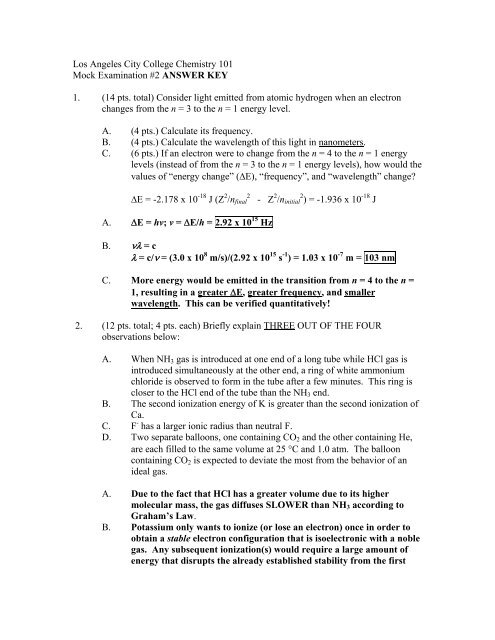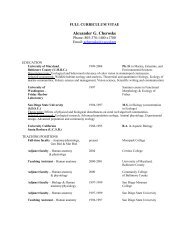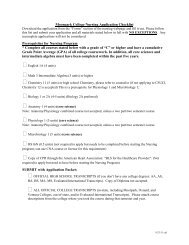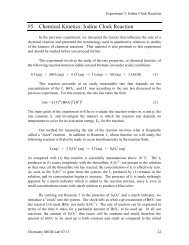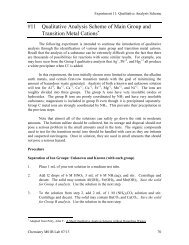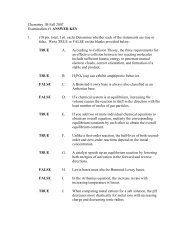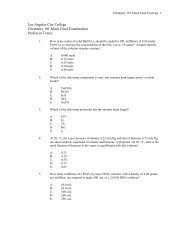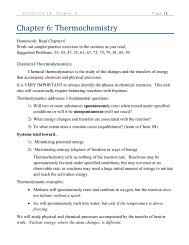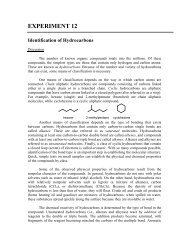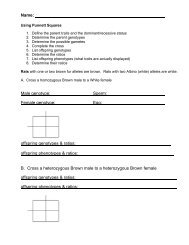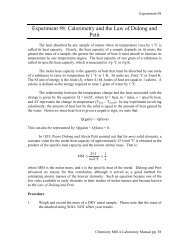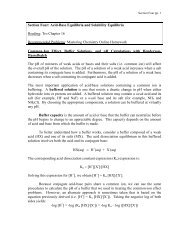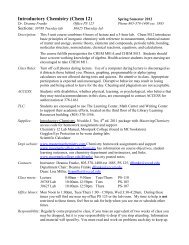Mock Examination #2 Answers - Moorpark College
Mock Examination #2 Answers - Moorpark College
Mock Examination #2 Answers - Moorpark College
Create successful ePaper yourself
Turn your PDF publications into a flip-book with our unique Google optimized e-Paper software.
Los Angeles City <strong>College</strong> Chemistry 101<strong>Mock</strong> <strong>Examination</strong> <strong>#2</strong> ANSWER KEY1. (14 pts. total) Consider light emitted from atomic hydrogen when an electronchanges from the n = 3 to the n = 1 energy level.A. (4 pts.) Calculate its frequency.B. (4 pts.) Calculate the wavelength of this light in nanometers.C. (6 pts.) If an electron were to change from the n = 4 to the n = 1 energylevels (instead of from the n = 3 to the n = 1 energy levels), how would thevalues of “energy change” (ΔE), “frequency”, and “wavelength” change?ΔE = -2.178 x 10 -18 J (Z 2 /n final2- Z 2 /n initial 2 ) = -1.936 x 10 -18 JA. ΔE = hv; v = ΔE/h = 2.92 x 10 15 HzB. νλ = cλ = c/ν = (3.0 x 10 8 m/s)/(2.92 x 10 15 s -1 ) = 1.03 x 10 -7 m = 103 nmC. More energy would be emitted in the transition from n = 4 to the n =1, resulting in a greater ΔE, greater frequency, and smallerwavelength. This can be verified quantitatively!2. (12 pts. total; 4 pts. each) Briefly explain THREE OUT OF THE FOURobservations below:A. When NH 3 gas is introduced at one end of a long tube while HCl gas isintroduced simultaneously at the other end, a ring of white ammoniumchloride is observed to form in the tube after a few minutes. This ring iscloser to the HCl end of the tube than the NH 3 end.B. The second ionization energy of K is greater than the second ionization ofCa.C. F - has a larger ionic radius than neutral F.D. Two separate balloons, one containing CO 2 and the other containing He,are each filled to the same volume at 25 °C and 1.0 atm. The ballooncontaining CO 2 is expected to deviate the most from the behavior of anideal gas.A. Due to the fact that HCl has a greater volume due to its highermolecular mass, the gas diffuses SLOWER than NH 3 according toGraham’s Law.B. Potassium only wants to ionize (or lose an electron) once in order toobtain a stable electron configuration that is isoelectronic with a noblegas. Any subsequent ionization(s) would require a large amount ofenergy that disrupts the already established stability from the first
ionization. Calcium readily ionizes twice to obtain a noble gasconfiguration.C. The extra electron in the fluoride ion causes enhanced repulsiveeffects between the electrons present and increased attraction by thepositively charged nucleus, thereby making the ionic radius largerthan the atomic radius of the parent fluorine atom.D. Larger volume of CO 2 (more massive due to higher MW) causes thisgas to deviate more from ideality than He.3. (8 pts.) Consider the neutralization reaction of sodium hydroxide and sulfuric acidin a coffee-cup calorimeter.2NaOH(aq) + H 2 SO 4 (aq) → Na 2 SO 4 (aq) + 2H 2 O(l)100.0 mL of 1.00 M aqueous NaOH and 100.0 mL of 1.00 M aqueous H 2 SO 4 ,each at 24.0 °C, were mixed. The maximum temperature achieved was 30.6 °C.Calculate the enthalpy change of reaction (in kJ/mol) of Na 2 SO 4 produced.Mass solution = .200 L x 1000 mL x 1.0 g = 200 g1 L mLΔT = (30.6 – 24.0) °C = 6.6 °C***NOTE: Since heat is “lost” by the reaction and “gained” by the solution,q solution = -q rxnq rxn = -m x s (OR 4.184 J/g °C) x ΔT = -5.5 x 10 3 JΔH (per mole Na 2 SO 4 formed) = -5.5 x 10 3 J/.05 mol = -110 kJ/mol4. (5 pts.) Calculate the ΔH° for the following reaction based on the provided data(note: graded ALL OR NONE):2N 2 (g) + 5O 2 (g) → 2N 2 O 5 (g)2H 2 (g) + O 2 (g) → 2H 2 O(l)N 2 O 5 (g) + H 2 O(l) → 2HNO 3 (l)N 2 (g) + 3O 2 (g) + H 2 (g) → 2HNO 3 (l)ΔH = -571.66 kJΔH = -92 kJΔH = -348.2 kJ2[N 2 (g) + 3O 2 (g) + H 2 (g) → 2HNO 3 (l)] 2ΔH = 2(-348.2 kJ)2[2HNO 3 (l) → N 2 O 5 (g) + H 2 O(l)]2ΔH = 2(92 kJ)2H 2 O(l) → 2H 2 (g) + O 2 (g)ΔH = 571.66 kJ2N 2 (g) + 5O 2 (g) → 2N 2 O 5 (g)ΔH = 59.26 kJ5. (8 pts.) A finely powdered solid sample of an osmium oxide with a mass of 1.509g is placed into a cylinder with a movable piston that can expand against theatmospheric pressure of 745 torr. Assume that the amount of residual air initially
present in the cylinder is negligible. When the sample is heated to 200 °C, it iscompletely vaporized, and the volume of the cylinder expands by 235 mL. Whatis the molar mass of the oxide? Assuming that the oxide is OsO x , what is thevalue of x?First, calculate the molecular mass of the oxide:PV = nRT ⇒ n = PV/RT = (745 torr = 0.98 atm)(0.235 L)/[(0.08206)(473 K)]n = 0.005933 molMM (g/mol) = 1.509 g/0.005933 mol = 254.3 g/molNext, calculate the amount of oxygen present in the oxide:Os + xO = 254.3 ⇒ 190.2 + 16x = 254.3 ⇒ x = 4Therefore, OsO 46. (8 pts.) The minimum energy necessary to overcome the attractive force betweenelectrons and the surface of silver metal is 7.52 x 10 -19 J. What is the velocity ofthe electrons ejected from silver, which are being irradiated with ultraviolet lighthaving a wavelength of 360 Å (1 m = 10 10 Å)?Kinetic Energy = hυ - hυ o = hυ - φ½ m e v 2 = hc/λ - φ (where λ = 3.6 x 10 -8 m)v = [2(hc/λ - φ)/m e ] 1/2 = 3.2 x 10 6 m/s7. (6 pts.) A proton is accelerated in a cyclotron to a very high speed that is knownto within 3.0 x 10 2 km/s. What is the minimum uncertainty in its position (massproton = 1.67 x 10 -27 kg)?Δx • Δp > h/4π ⇒ Δx • mΔv > h/4πΔx = h/(4πmΔv) = (6.626 x 10 -34 J s) / (4π[1.67 x 10 -27 kg][3.0 x 10 5 m/s])= 1.1 x 10 -13 m8. (8 pts.) Hydrogen peroxide was catalytically decomposed to form water vapor andoxygen gas, and 75.3 mL of oxygen gas was collected over water at 25 °C and742 torr. What mass of oxygen was collected? (at 25 °C, P water = 24 torr)2H 2 O 2 (l) → 2H 2 O(g) + O 2 (g)PV = nRTn = PV/RT = [(742 – 24) torr/760](0.0753 L)/[(0.08206)(298 K)] = 0.00291 molmass = 0.00291 mol O 2 x 32 g O 2 = 0.0931 g O 21 mol O 2
SHORT ANSWERS AND MINI-CALCULATIONS! (21 pts. total)9. A. (3 pts.) Write the COMPLETE electron configurations for the Ir + ion.How many valence electrons does this ion contain? Is it paramagnetic ordiamagnetic?1s 2 2s 2 2p 6 3s 2 3p 6 4s 2 3d 10 4p 6 5s 2 4d 10 5p 6 4f 14 5d 8 ; 8 valence electrons;paramagnetic.B. (2 pts.) A gaseous mixture containing 7.0 moles of nitrogen, 2.5 moles ofoxygen, and 0.50 moles of helium exerts a total pressure of 0.90atmospheres. What is the partial pressure of the nitrogen?χ nitrogen = n nitrogen /(n oxygen + n nitrogen + n helium )= 7.0 mol/(2.5 + 7.0 + 0.50) molχ nitrogen = 0.70Therefore, P nitrogen = χ nitrogen P = 0.70 (0.90 atm) = 0.63 atmC. (2 pts.) Real gases behave most nearly like ideal gases at LOW pressuresand HIGH temperatures.D. (4 pts.) Arrange the following types of photons of electromagneticradiation in order of increasing frequency: radio waves, infrared radiation,visible light, ultraviolet radiation.Radio waves < IR radiation < Visible light < UV radiationE. (2 pts.) What is a state function?A state function is a property of a system that is independent of itspathway. Examples of state functions include entropy, enthalpy, freeenergy, and internal energy.F. (5 pts.) Arrange the following species in order of DECREASINGatomic/ionic radii: Sr +2 , Se -2 , Br - , Kr, and Rb + .Se -2 > Br - > Kr > Rb + > Sr +2G. (3 pts.) Draw the various p-orbitals, making sure to clearly label yourcoordinate axis.
p x p y p z10. (10 pts.) What is an orbital? How is an orbital described by the four differentquantum numbers? Briefly list and describe the four different quantum numbers.What are the allowed values for each quantum number?An orbital is a region in space where there is a probability of finding anelectron. The size and energy level of the orbital is determined by theprincipal quantum number (n). These energy levels can vary from n = 1 to n= 7. The angular momentum quantum number (l) determines the shape ofthe orbital, and it can have values of l = 1, 2, … n – 1. The magneticquantum number (m l ) establishes the orientation of the orbital, and it canhave values of m l = +l including 0. Finally, the spin quantum number (m s )establishes the spin of the electron within a given orbital when placed in amagnetic field. The spin can be either +½ or -½.


